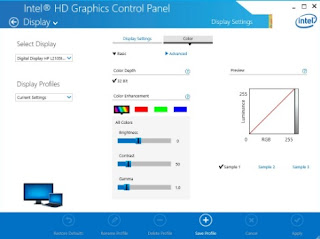Graphics Card Driver Lenovo G50-30 | Intel + NVIDIA Display Software For Windows
Like any other electronic device, the laptop is prone to overheating, which can cause severe damage and even shorten its lifespan. In this article, we will discuss some effective measures to prevent your Lenovo G50-30 laptop from overheating.
The first step in preventing laptop overheating is to ensure proper ventilation. Laptops generate heat as they operate, and this heat needs to be dissipated to maintain their optimal temperature. The Lenovo G50-30 has multiple cooling vents on its bottom and sides, designed to facilitate air circulation. Therefore, it is crucial to keep these vents clean and unobstructed. Regularly examine the vents and remove any dust or debris using a soft brush or compressed air. Clogged vents can significantly reduce airflow, leading to increased temperatures within the laptop.
Another effective method to prevent overheating is to use a laptop cooling pad. These are portable devices that improve laptop ventilation and dissipate heat more effectively. Cooling pads usually consist of fans and a metal or plastic surface that helps to extract heat from your laptop's underside. Investing in a good quality cooling pad can significantly enhance the heat dissipation capabilities of your Lenovo G50-30 laptop, ultimately preventing overheating.
Furthermore, managing your laptop's power settings can have a significant impact on its temperature. Modern laptops come with power management options that allow you to control performance according to your needs. Adjusting these settings can help reduce the strain on your laptop's hardware, thus minimizing the generation of excessive heat. Tweaking settings such as maximum processor state, display brightness, and hard disk power saving can significantly reduce the overall temperature of your laptop.
Choosing the right environment for using your laptop is also important in preventing overheating. Avoid placing your Lenovo G50-30 on surfaces such as beds, carpets, or pillows. These soft surfaces block the laptop's cooling vents, preventing proper airflow and leading to increased heat buildup. Instead, opt for hard, flat surfaces such as desks or tables that allow unrestricted airflow and facilitate cooling. Additionally, using your laptop in a well-ventilated room with proper air circulation can contribute to preventing overheating.
Regularly updating your laptop's software and drivers is another crucial step in preventing overheating. Manufacturers often release updates that address specific hardware or software issues, including those related to overheating. Keeping your Lenovo G50-30 up to date ensures that your laptop's components are functioning optimally, thus reducing the chances of overheating.
Lastly, monitoring your laptop's temperature can help you take preventive measures before any significant damage occurs. Numerous software applications are available that allow real-time monitoring of system temperature. These tools provide information such as CPU and GPU temperatures, fan speeds, and system utilization. By monitoring these parameters, you can identify any anomalies and take corrective actions promptly.
In conclusion, preventing your Lenovo G50-30 laptop from overheating requires a combination of effective measures. Ensuring proper ventilation, using a laptop cooling pad, managing power settings, choosing the right environment, updating software and drivers, and monitoring temperature are all essential steps in this process. By following these guidelines, you can protect your laptop from unnecessary damage and enjoy its performance for a long time. Remember, a little care goes a long way in maintaining the optimal functioning of your laptop.
 |
| Intel HD Graphics Control Panel |
VGA DRIVERS
((Driver)) INTEL Video Graphics Software For Windows 10 (64bit)((Driver)) NVIDIA Video Graphics Software For Windows 10 (64bit)
((Driver)) VGA (INTEL) Graphics driver for Windows 8.1 (64-bit)
((Driver)) VGA (NVIDIA) Graphics driver for Windows 8.1 (64-bit)
((Driver)) INTEL VGA Graphics card - Display Software For Win 7 (64bit)
((Driver)) NVIDIA VGA Graphics card - Display Software For Win 7 (64bit)